Stem Cell Myth Buster
Research pioneer uses ‘Stem Cell for Dummies’ book to dispel misconceptions about stem cell research
Ioana Patringenaru | April 12, 2010
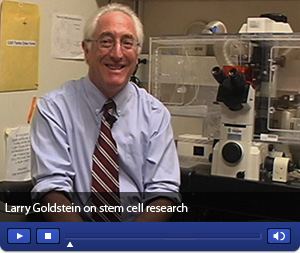
Watch a video of Larry Goldstein discussing his new book, "Stem Cells for Dummies" in which he seeks to dispel myths about stem cell research.
Working on stem cell research is a lot like standing on a beach looking at an undiscovered continent: you can see mountain ranges, forests and rivers in the distance; you know great resources are awaiting on the horizon. But you need to explore to figure out the best path to get there.
That’s how Larry Goldstein, the director of UC San Diego’s Stem Cell Program, explains what he and his colleagues on campus are trying to do. Recently, Goldstein took his role as a kind of spokesperson for stem cell research one step farther by becoming the co-author of “Stem Cells for Dummies.”
Goldstein will talk about the book at 12:30 p.m. Thursday at the UCSD Bookstore. He also will sign books. “Stem Cells for Dummies,” which hit bookstores in February, includes chapters designed to help readers understand the basics of stem cell science, its history, as well as stem cells’ potential for curing disease and testing drugs. The book also seeks to dispel myths about stem cell research and explain ethical, religious, moral and political questions surrounding the issue.
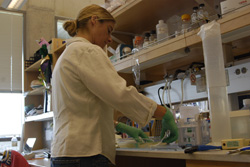
Jessica Young, a post-doctoral fellow in Goldstein's lab, tests for protein.
The controversy over stem cell research has brought about many misconceptions but hasnt made up for the lack of information on the topic, Goldstein said. Yet Americans are still asked to vote on the issue, or at least choose elected representatives who will vote on it. A few might have to decide whether to undergo treatment that involves stem cells.
“As an academic scientist, it is very important for people who have the knowledge we all have to communicate it to the outside world because, at the end of the day, we depend upon public support and understanding for us to be able to do our work,” Goldstein said when asked why he decided to co-author the book.
It’s hard to imagine anyone more qualified to write that book than Goldstein. A professor in the department of cellular and molecular medicine at the UCSD School of Medicine, Goldstein has served as co-chair of the scientific advisory committee for the campaign to pass Proposition 71, a voter-endorsed measure to provide $3 billion in stem cell research funding in California. He has also appeared many times before the California legislature and the U.S. Congress and Senate to testify in support of stem cell research and biomedical research funding. He has conducted research on stem cells, both in mice and humans, for many years.
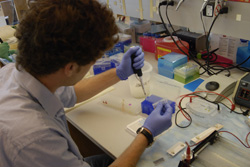
Jonathan Boulanger-Weill, an intern from the top-rated Ecole Nationale Superieure in Paris, France, checks for a DNA mutation.
His experience in this area is likely why a literary agent approached him to write a book in the “Dummies” series. Goldstein thought it sounded like a good idea. But before he said yes to the idea, he had some conversations with colleagues and friends.
“I wanted to be sure that they felt it was appropriately dignified and in tune with the mission of our institution,” Goldstein explained. “And after talking to them, it became clear that there was no reason not to do it. There were a lot of good reasons to do it.”
One of the reasons was to point out that several of the myths that have become pervasive about stem cell research are wrong. It’s important, for example, to make clear that embryonic stem cells don’t come from aborted fetuses, Goldstein said. It’s also not true that President George W. Bush banned stem cell research, as some people believe, the UCSD scientist added. The Bush administration did place some limits on the science that could be done, but it was also instrumental in giving it a jumpstart, Goldstein said. The Bush policies later became obsolete and needed to be re-examined by a new administration.
It’s also important to understand that stem cells can’t cure all diseases at this point in time, Goldstein said. They have turned out to be useful in the treatment of blood disorders, such as some kinds of leukemia, and in some skin transplant procedures. But all other stem cell treatments are experimental. There really isn’t any credible evidence that transplants of adult blood-forming stem cells work for heart disease, Alzheimer’s or Lou Gehrig’s disease, Goldstein said.
This myth of a miracle cure is particularly dangerous because a cottage industry of clinics has sprouted abroad that deliver so-called stem cell therapy for any disease—at a steep price. “In most of those cases, there is no strong proof or evidence that these things really work,” Goldstein said. “It's almost as bad as faith healing.”
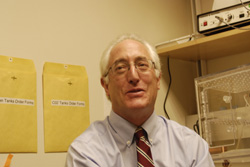
Goldstein has been on the UC San Diego faculty since 1993.
The true promise of stem cells is that, in the future, as research progresses, new therapies and new methods for drug discovery will indeed emerge, Goldstein said. “Remember that research means inquiring about, learning about things that we don't know yet,” he said. “And so we don't know what we'll find in many cases, and there will be disappointments, as well as exciting breakthroughs.” That’s where the metaphor of a new continent ready to explore comes in.
Exploration, of course, comes with a price tag. The Obama administration is trying to help where it can, Goldstein said. But federal funding for medical research has failed to keep up with inflation in the past decade. “If you look at the magnitude of the problems we're trying to solve and you look at the size of our investment in solving these problems, we're way under-invested,” the UCSD researcher said. “What that means is that many good opportunities that might lead to breakthroughs are not being followed up.”
Meanwhile, in California, the promise of stem cell research is backed by solid funding, namely the $3 billion from Prop. 71, a ballot initiative voters approved in 2004. Two years ago, the governing board of the California Institute for Regenerative Medicine, which is in charge of doling out Prop. 71 money, granted $43 million to the San Diego Consortium for Regenerative Medicine to build a center dedicated to stem cell research on the Torrey Pines Mesa. The consortium includes UC San Diego, the Burnham Institute for Medical Research, the Salk Institute for Biological Studies and The Scripps Research Institute.
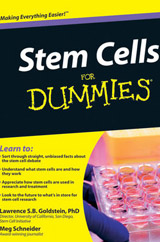 Book Signing:
Stem Cells for Dummies Book Signing:
Stem Cells for Dummies
12:30 p.m. Thursday UCSD Bookstore
An official groundbreaking for the facility, which is being built on UCSD land across from the Salk Institute for Biological Studies on North Torrey Pines Road, took place March 26. Officials said it is set to open within the next 18 months. The space will allow scientists from many disciplines to come together and come up with creative solutions to some of the problems stem cell researchers face, Goldstein said. It will also attract more investigators and more companies to the area, turning San Diego into a bigger stem cell research hub, Goldstein predicted. UC San Diego is a wonderful setting to conduct this kind of interdisciplinary research, he added.
“When you're trying to use a new technology to solve tough problems in human biology and medicine, having a community where scientists and clinicians and engineers actually want to work together to solve these problems with new technologies is a wonderful place to be,” he said.

|